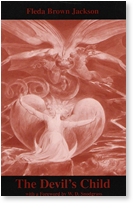 Carnegie Mellon University Press has just informed me that they’re shifting their distribution from Cornell University Press to The University Press of New England, and that their authors can either buy their stored books or the books will be destroyed. I have just bought what’s left of The Devil’s Child and The Women Who Loved Elvis All Their Lives.The Devil’s ChildCarnegie-Mellon University Press 1998“This dark, ambitious narrative full of voices, echoes and whispers of anguish is deftly plotted and carefully crafted. Here is a challenging poetry of action and remembrance and the sheer, downright, daily human grotesque. But it is also a poetic sequence that does something altogether more difficult: it holds our interest and its own lyric balance at one and the same time. It compels the sort of music from pain which is hard to forget.” —Eavan Bolan. . . . . . .Remaindered books are always sad for the writer. The love, the time, the struggle in the making, and then the book turns up in some used bookstore for fifty cents. Or the entire unsold lot is shredded. We are frail and fleeting on the earth, after all.I want to remember The Devil’s Child, and I want you to buy it, if you can stand to read it. You can order it through Brilliant Books http://www.brilliant-books.net/ or through Horizon Books www.horizonbooks.com/ . This book represents my hardest and possibly best work ever, my dredging up the raw material of my own soul to make Barbara’s story. It is her story, but it is also the story of what we all don’t want to look at. It is a true story. The book got one very favorable review in Poetry Magazine but didn’t get caught up in whatever publicity wheel that carries books into the big world. It got a lot of interest wherever I read from it. But as I said, it is not a book for the fainthearted. I will introduce you to it here, and I will continue this essay in another blog post:
Carnegie Mellon University Press has just informed me that they’re shifting their distribution from Cornell University Press to The University Press of New England, and that their authors can either buy their stored books or the books will be destroyed. I have just bought what’s left of The Devil’s Child and The Women Who Loved Elvis All Their Lives.The Devil’s ChildCarnegie-Mellon University Press 1998“This dark, ambitious narrative full of voices, echoes and whispers of anguish is deftly plotted and carefully crafted. Here is a challenging poetry of action and remembrance and the sheer, downright, daily human grotesque. But it is also a poetic sequence that does something altogether more difficult: it holds our interest and its own lyric balance at one and the same time. It compels the sort of music from pain which is hard to forget.” —Eavan Bolan. . . . . . .Remaindered books are always sad for the writer. The love, the time, the struggle in the making, and then the book turns up in some used bookstore for fifty cents. Or the entire unsold lot is shredded. We are frail and fleeting on the earth, after all.I want to remember The Devil’s Child, and I want you to buy it, if you can stand to read it. You can order it through Brilliant Books http://www.brilliant-books.net/ or through Horizon Books www.horizonbooks.com/ . This book represents my hardest and possibly best work ever, my dredging up the raw material of my own soul to make Barbara’s story. It is her story, but it is also the story of what we all don’t want to look at. It is a true story. The book got one very favorable review in Poetry Magazine but didn’t get caught up in whatever publicity wheel that carries books into the big world. It got a lot of interest wherever I read from it. But as I said, it is not a book for the fainthearted. I will introduce you to it here, and I will continue this essay in another blog post:
The Devil of a Subject
In Iraq, amid the daily horrors, a hostage was beheaded. Then another. The videos were on the Internet. I didn’t see them, but supposedly Abu Musab al-Zarqawi personally beheaded one of them. In another, black-hooded insurgents stand over a kneeling, weeping blindfolded man, the sabre descending, finally sawing through bone, the head pulled off and lifted to the light. A short while before, there were the pictures of naked prisoners being abused by American soldiers. I kept repeating to myself lines from my third book of poems. They come from Barbara, a woman raised in a Satanic cult, who describes in ghastly detail the sexual, psychological, and physical abuses of her life, which split her into multiple personalities:Sometimes it makes me madthat you don’t know—underneath, any of usmight do anything....there’s an ecstasy like sexin the most horrible thing that can happen. It has been a long time, thirteen years, since I published The Devil’s Child, and probably sixteen years since I started those poems, but they still pound at me like a headache. Terror all around. The issue is what to do with it—pretend to ignore it, look at it askance while I go about my life, or focus on it and go crazy with anger and despair? Are there other ways? An old misery comes up in me: I’m a child caught in an out-of-control household. It’s that feeling I try not to sink into, that I tried not to sink into as I was writing the book.How does one approach the unspeakably awful? And how does one make it “true” on paper? The Devil’s Child came out in the wake of many revelations of cult sexual abuse, many accusations that the “recovered memories” were false. I believed that my main character, Barbara—a real person whose life I painstakingly documented—was telling the truth, and I still do. I see what’s around me. But a poem offers a difficult route to truth, and sometimes to a different truth altogether.One time when I was feeling stuck with the book, I asked for help from a well-known poet who had written wonderful long narrative poems. “What do you want to write this kind of stuff for?” he wrote back. “The world is sad and hard enough. We need light, joy, instead of this.” “Well,” I thought but didn’t say, since he was an old man, “I’m going to tell what I believe is the truth.” As did Michael Moore, when he produced Fahrenheit 9/11, as did the soldier who photographed the hundreds of coffins coming in at Dover Air Base from the Iraq war. It’s not particularly a poetic response, but a natural one for me, who grew up in an insular family, with two parents who were pretty much children themselves, ranting and crying with little concern for the effect on us children, and a severely retarded brother who had grand mal seizures. I felt I was living in a private bubble of my own misery, all of it invisible to the outside world. I knew a little about how the real Barbara felt, wanting the validation of print for her story, wanting people to know that the worst can happen, does happen. And that if a person splits away from the misery, shuts it away, the misery is heartened, heightened, free to go where it will.I met Barbara years ago in a therapy group I joined for a short time after my divorce. When I first came to the group, she was describing some incident in her past, hesitating as if she weren't sure that what she had to say belonged to the same world the rest of us lived in. I assumed she was telling a dream, but I was new, so I kept my mouth shut. By the second session, I was pretty sure I was wrong. I asked her if I could use her story in poems.At first I was fascinated by what she had to tell me—it was sensational, violent, and psychologically complex. But that was my crafty, analytic mind. My other mind was feeling her terror coming up against my own old terrors—minor, compared to hers, but there, nonetheless. Before I finished her voice in the poems, the Barbara I wrote about was a wild exaggeration of myself. Her story seemed to me all about images, not thoughts—the way images ravish us, positively and negatively, in the subconscious, particularly when they're frozen into icons, including religious icons.. . . . . . more to come
